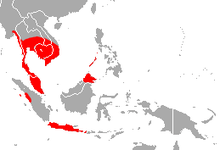Acuminate horseshoe bat
The acuminate horseshoe bat (Rhinolophus acuminatus) is a species of bat in the family Rhinolophidae. It is found in Brunei, Cambodia, Indonesia, Laos, Malaysia, the Philippines, and Thailand. It lives in forests and urban areas.[1]
| Acuminate Horseshoe Bat | |
|---|---|
 | |
| Scientific classification | |
| Kingdom: | Animalia |
| Phylum: | Chordata |
| Class: | Mammalia |
| Order: | Chiroptera |
| Family: | Rhinolophidae |
| Genus: | Rhinolophus |
| Species: | R. acuminatus |
| Binomial name | |
| Rhinolophus acuminatus Peters, 1871 | |
 | |
| Acuminate Horseshoe Bat range | |
Taxonomy and etymology
It was described as a new species in 1871 by German naturalist Wilhelm Peters.[2] Its species name "acuminatus" is Latin for "pointed." The inspiration for this name was perhaps its "sharply upwards pointed sella."[3]
Description
Its forearm length is 48–50 mm (1.9–2.0 in); its tail length is 21–31 mm (0.83–1.22 in); its ear length is 20–21 mm (0.79–0.83 in). It weighs 11.5–13.5 g (0.41–0.48 oz).[3]
Biology and ecology
It is nocturnal, roosting in sheltered places during the day such as inside caves or on the undersides of palm leaves.[3] It roosts in small colonies.[1]
Range and habitat
It is found in several countries in Southeast Asia, including Cambodia, Indonesia, Laos, Malaysia, Myanmar, Thailand, and Vietnam.[1]
Conservation
It is currently evaluated as least concern by the IUCN—its lowest conservation priority. It meets the criteria for this assessment because it is a widespread species considered locally common. Its range includes protected areas. It lacks major threats, although cave disturbance by humans is a local threat.[1]
References
- Thong, V.D.; Thanh, H.T.; Soisook, P.; Csorba, G. (2019). "Rhinolophus acuminatus". IUCN Red List of Threatened Species. 2019: e.T19520A21974227.
- Peters, W. (1871). "Über die Gattungen und Arten der Hufeisennasen, Rhinolophi". Monatsberichte der Königlichen Preussische Akademie des Wissenschaften zu Berlin. 1871: 308–309.
- Phillipps, Q.; Phillipps, K. (2016). Phillipps' Field Guide to the Mammals of Borneo and Their Ecology: Sabah, Sarawak, Brunei, and Kalimantan. Princeton University Press. p. 104. ISBN 0691169411.
